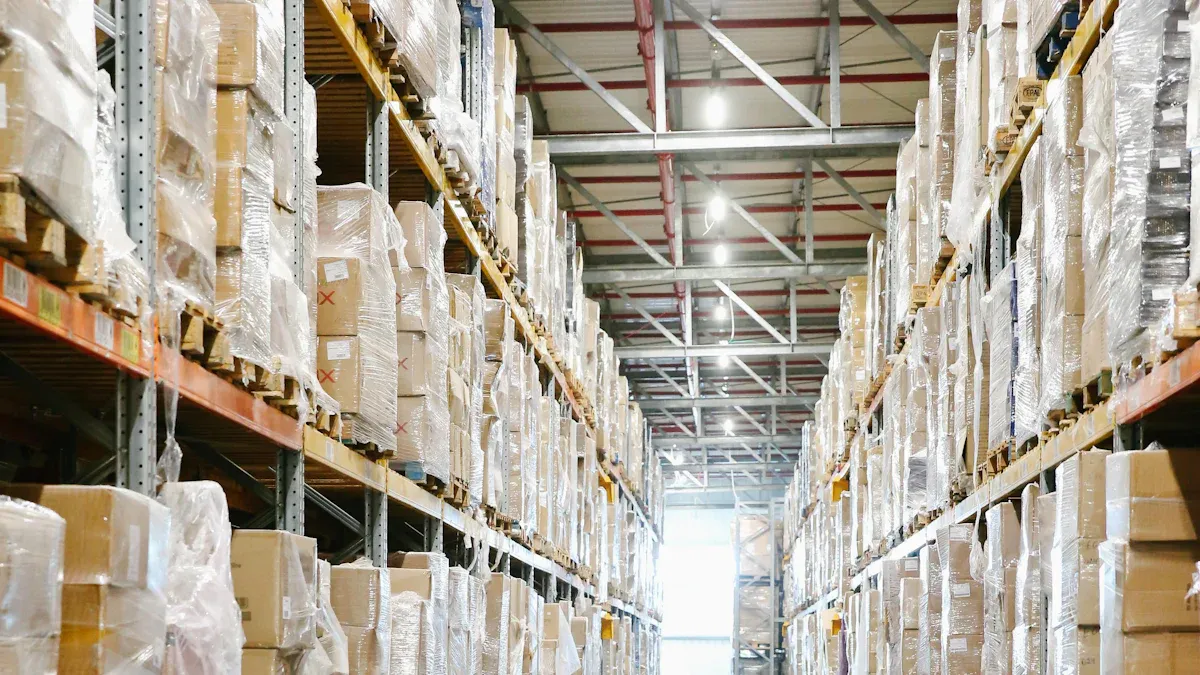Effective Methods to Streamline Supply Chains with Logistics Partners

In the logistics industry, improving supply chains boosts speed and success. Businesses must adjust since 70% want real-time updates, but only 6% get them. Logistics partners help by using tools like Electronic Data Interchange. These tools make tasks automatic, cut mistakes, and improve work. JUSDA, a world leader in the logistics industry, helps businesses with smart ideas, data tools, and easy teamwork.
Key Takeaways
Make your supply chain better with tools like AI and IoT. These tools help follow shipments and guess demand, saving money and time.
Pick the best logistics partner by checking their work, tools, and service. A good partner makes your supply chain stronger and keeps customers happy.
Create clear goals and KPIs to check how well your supply chain works. This shows what needs fixing and keeps you and your partner responsible.
The Basics of Making Supply Chains Better
What Does Supply Chain Optimization Mean?
Supply chain optimization means making supply chains work better and cost less. It’s about balancing what’s needed with what’s available. Companies use tools like transport software to track shipments or AI to improve tasks. These tools help cut waste, speed up deliveries, and increase profits.
Improving supply chains isn’t a one-time job. It needs regular checks on costs, service, and customer needs. By doing this, companies can build supply chains that meet customer demands and adjust to market changes.
Why Is Supply Chain Optimization Important for Businesses?
Good supply chain management helps businesses grow. Studies show 57% of companies think it gives them an edge. Better supply chains lower costs, improve services, and make work smoother. For example, in disaster relief, supply chains take up 60–80% of costs. Fixing these processes saves money and improves results.
Businesses that focus on supply chains can quickly adapt to changes. This helps them stay ahead in the logistics world and keep customers happy.
How Logistics Partners Help with Supply Chains
Logistics partners are key to better supply chains. They bring skills, tools, and resources to make logistics easier. For instance, Penske Logistics helped a drink company set up new warehouses to beat competitors. Covenant also made a packaging company’s supply chain stronger, helping them do better in the market.
These partners also help manage risks with tracking, inventory checks, and smart predictions. By working with logistics partners, companies can focus on their main work while keeping supply chains strong and efficient.
Supply Chain Optimization Strategies for Effective Collaboration
Using Technology to Improve Logistics
To stay ahead in logistics, use technology to improve your supply chain. Tools like AI, IoT, and cloud computing make tracking and decisions easier. For example, predictive maintenance lowers costs, saving up to $24,100 per truck every 100,000 miles. These tools also help predict demand, so you can adjust to changes quickly.
Companies like SpeedyDeliver show how technology helps. They cut fuel costs by 20% in three months using route optimization. Their on-time deliveries went up by 15%, making customers happier. AI-based inventory systems let you track stock in real time. This reduces waste and improves how you manage inventory.
Tip: Use technology to save money and improve supply chain performance.
Better Routes and Freight Management
Planning routes and managing freight well saves time and money. Smart routing tools lower transport costs and improve delivery times. Companies using these tools save up to 20% on transport costs and deliver on time more often.
Last-mile delivery costs are rising, now making up 53% of shipping expenses. The market for last-mile delivery is expected to grow from $146.81 billion in 2023 to $340.56 billion by 2032. By improving routes and freight, you can deliver more with the same trucks, avoid delays, and keep customers happy.
Note: Route tools cut costs and help meet customer needs better.
Smarter Inventory Management with JUSDA's Solutions
Managing inventory is key to a good supply chain. JUSDA offers tools like eVMI and JusLink for real-time tracking. These tools help predict demand, lower costs, and make operations smoother.
JUSDA has warehouses covering 2.5 million square meters worldwide. Their Vietnam warehouses serve industries like electronics and cars with clean rooms and bonded spaces. Using these solutions helps you manage stock better, reduce risks, and improve service.
Feature | Benefit |
|---|---|
Real-time tracking | Know where your inventory is anytime |
Advanced technology | Faster order processing with automated systems |
Global warehouse network | Store and ship goods efficiently across regions |
JUSDA’s focus on innovation keeps your supply chain flexible and ready for changes.
Clear Communication and Data Sharing
Good communication and data sharing are vital for teamwork in supply chains. Reliable systems and accurate data help everyone make better decisions. Secure platforms like SecureChat and ShieldVault protect data and build trust.
For instance, PrivacyShield helped a tech company follow GDPR rules, improving its image and customer trust. Clear communication also helps create quick response plans, making supply chains flexible. Adding quality checks ensures smooth teamwork and reliable services.
Tip: Use secure and clear communication to build trust and improve supply chains.
Sustainability and Future Trends in the Logistics Industry

The Growing Importance of Green Logistics
Green logistics focuses on using eco-friendly methods in logistics. Companies now use strategies to cut carbon emissions and work better. For example, electric vehicles are popular because they save money and help the planet. Biodegradable and recyclable packaging also reduces waste and pollution.
Reverse logistics is important for handling returns and recycling items. These methods support global sustainability goals and make supply chains better by cutting waste. But, problems like poor planning and lack of support can slow progress. To fix this, companies need teamwork and renewable energy like solar and wind power.
Note: Green logistics is key for long-term supply chain sustainability.
AI and Automation in Supply Chain Optimization
AI and automation are changing how supply chains work. AI tools predict demand, helping businesses avoid running out of stock. Automation, like robots, speeds up warehouse tasks and reduces mistakes.
AI systems also improve shipping by finding faster routes. Predictive maintenance tools stop equipment from breaking down. These technologies make supply chains faster and ready for changes in the market.
Tip: Use AI and automation to keep your supply chain competitive.
Data-Driven Decision Making for Predictive Supply Chain Management
Using data helps businesses plan better and save money. Historical data shows trends, helping companies manage inventory and cut costs. Unified systems make data clear and easy to use, showing problems quickly.
Big companies like Amazon and Unilever use data to improve supply chains. Amazon predicts demand to avoid extra stock and keep customers happy. Unilever uses data to lower inventory and improve visibility. These examples show how accurate data makes supply chains stronger and more efficient.
Callout: Data-driven decisions help businesses stay ahead in today’s market.
Building Strong Partnerships with Logistics Operators
Picking the Best Logistics Partner for Your Supply Chain
Choosing the right logistics partner is very important. A good partner can make your work easier, save money, and keep customers happy. To choose wisely, check partners using key factors.
What to Look For | |
|---|---|
Performance Metrics | Check delivery times, customer loyalty, and success stories. |
Scalability | Make sure they can grow or shrink services as needed. |
Technology | Look for tools like TMS and WMS for better tracking and planning. |
Reliability | See if they deliver on time and handle problems well. |
Customer Service | Look for quick responses and solutions to issues. |
Today’s logistics depend a lot on technology. Partners with tools like TMS and WMS can improve work and give real-time updates. This keeps your supply chain fast and ready for changes.
Pro Tip: Great customer service shows a strong logistics partner. Pick one that solves problems quickly and communicates well.
Flexibility is also key. A good partner should adjust services when demand changes. They should also handle surprises to keep your supply chain running smoothly.
To decide, follow these steps:
Check how often they deliver on time.
Ask how they deal with sudden problems.
Get feedback from their current customers.
By focusing on these points, you can find a partner that fits your goals and plans.
Setting Clear Goals and KPIs
Setting clear goals and key performance indicators (KPIs) is important. KPIs help track progress and match your supply chain goals.
Here are real-life examples:
Case Study | Results |
|---|---|
Retail Giant’s Transformation | Saved 20% on logistics costs; Faster deliveries by 15%; Easy market growth. |
Automotive Industry Integration | Cut extra stock by 25%; Kept quality high; Handled busy times better. |
These examples show why clear goals matter. For example, cutting costs or speeding up deliveries can improve your supply chain.
When setting KPIs, focus on things like:
How often deliveries are on time.
How accurate inventory counts are.
Shipping costs per order.
Customer happiness scores.
Clear goals also help everyone stay accountable. You and your partner can use KPIs to find problems and fix them. This teamwork keeps improving your supply chain.
Building Long-Term Partnerships with JUSDA
A strong partnership needs trust, honesty, and shared goals. JUSDA shows these values with smart tools and great service in supply chain management.
JUSDA has over 155 service points and huge warehouses worldwide. Their tools, like JusLink and eVMI, track inventory in real time and make teamwork easy. These tools keep your supply chain flexible and ready for changes.
To build a strong partnership, focus on open communication. Regular reviews and sharing data help solve problems and find new ideas. JUSDA’s quick problem-solving and focus on customer happiness make them a great partner.
Callout: Good supplier relationships make supply chains stronger. With JUSDA, you get advanced tools, expert help, and constant improvements.
Working with JUSDA not only improves your supply chain but also helps your business grow in the logistics world.

JUSDA Solutions
To provide you with professional solutions and quotations.
Improving supply chains with logistics partners keeps customers happy. It also lowers costs and helps businesses stay competitive. Using tools like technology, better routes, and eco-friendly methods boosts efficiency. JUSDA offers smart tools like JusLink and eVMI to match logistics with company goals. These tools add value for customers and make your business stronger. Choose JUSDA for lasting success.
See Also
Unlocking Logistics Savings: Expert Tips for Supply Chain Success
Transforming Logistics: How Supply Chain Innovations Drive Change
Essential Strategies for Successful Supply Chain Optimization
Effective Solutions for Supply Chain Challenges in High-Tech Manufacturing
Improving Supply Chains Through Innovative Cloud Technology Solutions
